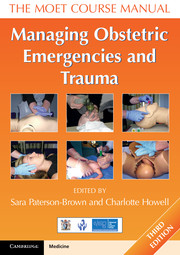Book contents
- Frontmatter
- Dedication
- Contents
- Working Group
- About the authors
- Acknowledgements
- Abbreviations
- Section 1 Introduction
- Section 2 Recognition
- Section 3 Resuscitation
- Section 4 Trauma
- 13 Introduction to trauma
- 14 Domestic abuse
- 15 Thoracic emergencies
- 16 Abdominal trauma in pregnancy
- 17 The unconscious patient
- 18 Spine and spinal cord injuries
- 19 Musculoskeletal trauma
- 20 Burns
- Section 5 Other medical and surgical emergencies
- Section 6 Obstetric emergencies
- Section 7 Triage and transfer
- Section 8 Human issues
- Index
13 - Introduction to trauma
- Frontmatter
- Dedication
- Contents
- Working Group
- About the authors
- Acknowledgements
- Abbreviations
- Section 1 Introduction
- Section 2 Recognition
- Section 3 Resuscitation
- Section 4 Trauma
- 13 Introduction to trauma
- 14 Domestic abuse
- 15 Thoracic emergencies
- 16 Abdominal trauma in pregnancy
- 17 The unconscious patient
- 18 Spine and spinal cord injuries
- 19 Musculoskeletal trauma
- 20 Burns
- Section 5 Other medical and surgical emergencies
- Section 6 Obstetric emergencies
- Section 7 Triage and transfer
- Section 8 Human issues
- Index
Summary
Trauma is an example of a multisystem, life-threatening illness. Like all life-threatening emergencies, the management of major trauma requires a systematic approach. Developing an understanding of such an approach and applying it to any life-threatening emergency will help to optimise care.
There are marked differences in the epidemiology of trauma in different countries. In the UK, there are an estimated 10 000 deaths from trauma each year – approximately 30 deaths each day, of which road traffic accidents are the most common cause.
Trauma occurs in up to 7% of pregnancies and is most commonly due to suicide (most common postnatally), road traffic accidents (equal frequency throughout pregnancy), domestic violence (more common before 18 weeks), falls (between 20 and 30 weeks) and burns.
The Confidential Enquiry into Maternal Deaths has highlighted suicide as a major cause of death recently and in the 2006–08 triennium there were 29 reported suicides. Of these deaths, 87% were by violent means, which is a less common method of suicide in the nonpregnant female. The most common methods involved hanging or jumping from a height, but self-immolation also occurred. The Enquiry reported 17 cases of road traffic accidents and 11 cases of murder, but of all the 344 deaths assessed, 34 of these women had suffered from domestic violence. The obstetrician is likely to be called to any case of trauma in the pregnant woman.
- Type
- Chapter
- Information
- Managing Obstetric Emergencies and TraumaThe MOET Course Manual, pp. 159 - 162Publisher: Cambridge University PressPrint publication year: 2014

